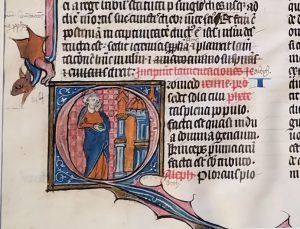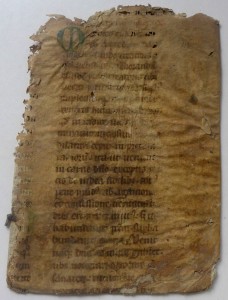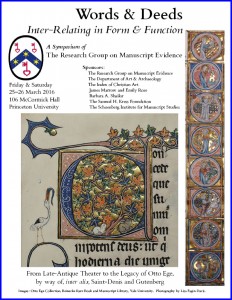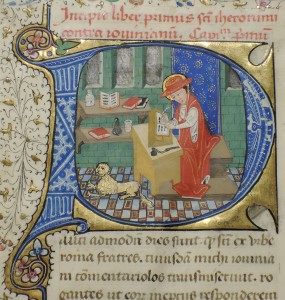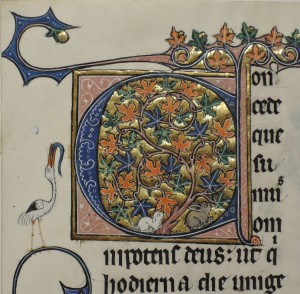RGME Workshops
on
“The Evidence of Manuscripts, Etc.”
[Posted on 31 December 2024, with updates]

Private Collection, Pieces of a Vellum Leaf from a Medieval Manuscript: Recto. Photography by Mildred Budny.
In 2024 the RGME launched its series of Workshops dedicated to “The Evidence of Manuscripts, Etc.”
The series began in October 2024. So far they take place online as sessions of one and one-half hours, including scope for questions and answers. They are designed to teach and to crowdsource research on original materials, which may be newly discovered and so far unknown.
The workshops are free of charge. All are welcome to attend, join the discussion, and participate in the study of manuscripts and other original sources.
With this series, we revive an approach to collaborative events “On the Evidence of Manuscripts” which we nutured in our early years.
Our Early Series of Seminars
on “The Evidence of Manuscripts” (1989–1995)
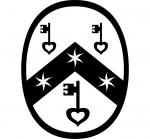
RGME Logo in Black-and-White.
In its early years while based at the Parker Library of Corpus Christi College, Cambridge, the Research Group on Manuscript Evidence held a series of Seminars, Workshops, and Symposia (organized or co-organized by Mildred Budny) variously at the Parker Library and at other centers in England, Japan, and the United States. At libraries, the sessions took place over relevant manuscripts in the collection, supplemented by photographs. Elsewhere, the sessions were usually accompanied by displays or exhibitions of photographs (mostly by Mildred Budny).
In England, many of these sessions belonged to the series of Research Group Seminars on “The Evidence of Manuscripts.” Often they took place at the Parker Library in the company of the manuscripts under examination, sometimes also with early-printed books.
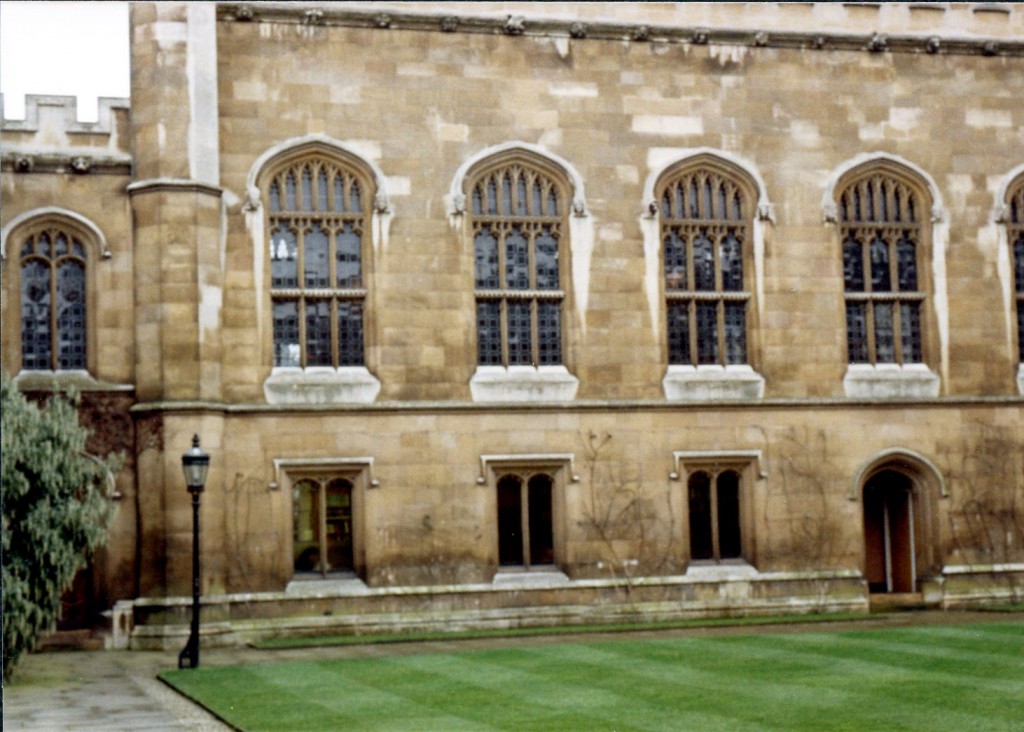
View Toward the Entrance to the Parker Library in mid-1989. Photograph © Mildred Budny.
Harking back to our first series of events as the RGME, in the series of RGME Seminars on “The Evidence of Manuscripts” (1989–1994), this new series brings forward for collective study (‘crowdsourcing’ and collaboration) the original specimens as witnesses in our own RGME Special Collections and the RGME Lending Library
Foreground

View of the Pont Neuf, Paris. Photograph by Claudio Mota via https://www.pexels.com/photo/pont-neuf-bridge-in-paris-9999874/.
Registration for the Workshops
To register for individual workshops in the series, please visit the RGME Eventbrite Collection for “The Evidence of Manuscripts, Etc.”
Workshop 1
“Introducing the Farrell Leaf”
Sunday 17 November 2024
The first Workshop considers practices of manuscript studies and introduces the first specimen for collaborative examination. We meet the medieval Latin Vulgate Bible leaf from the Book of Numbers in the Jennah Farrell Leaf, now on loan to the RGME “Lending Library”.
For background information about this leaf based on the characteristics of the leaf itself and the owner’s knowledge about its provenance with reference to the previous owner, see

Medieval Latin Vulgate Bible manuscript: Verso, top. Photography by Mildred Budny.
Workshop 2
“Follow-Up for the Farrell Leaf”
Sunday 15 December 2024
At this workshop, comparing notes about our investigations which followed Workshop 1, we agreed that, most probably (and perhaps almost certainly), this leaf formerly belonged to the Saint Albans Bible, dispersed only in recent decades and now having its surviving leaves widely separated through the marketplace. On this bible see, for example:
Fuller confidence in this proposed identification of the Farrell Leaf as part of the Saint Albans Bible might have to await the discovery or recognition of one of the leaves which formerly stood immediately adjacent, that is, directly preceding this leaf or directly following it, with a continuous flow of the text from leaf to leaf.
We continue our explorations.

Medieval Latin Vulgate Bible manuscript: Verso, top. Photography by Mildred Budny.
Workshop 3
“The Farrell Leaf and its Context”
Sunday 12 January 2025
Next, we consider the Farrell Leaf in its context:
- in its original manuscript,
- in relation to other leaves bearing the work of its scribe and scribal artist,
- among other representatives in its time of the genre of Vulgate Bible manuscripts of medium format, and
- as a witness to its production and deconstruction, whereby individual leaves became scattered through the sales room, sometimes multiple times over before reaching ‘Forever Homes’.

Collection of Jennah Farrell, Latin Vulgate Bible Leaf: Verso, Bottom of Columns. Photograph by Mildred Budny.
Registration:
*****
Workshop 4
“Manuscript Fragments Compared:
The Saint Albans Bible and Otto Ege MS 14”
Sunday 23 February 2025
Continuing our exploration of the Saint Albans Bible, from the previous Workshops (1–3), we now expand our scope to set its complex characteristics as a fragmentary, dispersed Latin Vulgate Bible manuscript in a wider context. Also, we can reveal another leaf from the same Bible, which came to our attention following Workshop 3.
We thank our Associate, Richard Weber, for sharing information and photographs about the leaf in his collection from the same manuscript, but from the New Testament portion.

Collection of Richard Weber, Leaf from the Saint Albans Bible, Recto: Top Right. Photograph by Richard Weber.
Note that, with permission, our blog has published discoveries for other leaves in Richard Weber’s collection. See:
At our Workshop, we may survey our progress for the Saint Albans Bible, as we collectively continue to explore the extent, range, and nature of its surviving parts, or to conjure up other parts for whom whereabouts are unknown from other sources as well as from the evidence of the leaves themselves or reports about them or the original manuscript. We can report the progress of the work to shape a list of known survivors, their present locations, their contents (which part of the Bible or the companion apparatus such as the glossary of Interpretations of Hebrew Names), span of text upon the individual fragments, and the citations about the manuscript and its fragments in books, articles, blogs, or sales catalogues.
In taking into consider other relatives of the genre, our quest can be twofold, taking into account
1) the genre of medieval Vulgate Bible manuscripts containing the full text of the Bible, both Old and New Testaments, within a single volume; and
2) such manuscripts which have befallen the fate of dismemberment and distribution of individual leaves or groups of leaves through the saleroom or other means.
Accordingly, first we might consider the possible survivors of other works by the same scribes, artists, and workshop.
Next we can take note of other Vulgate Latin Bibles of the period which may have suffered the same fate through fragmentation, dispersal, and restorative efforts to recognize the fragments wherever they might survive, study their evidence closely, and, insofar as possible reconstruct the fragments at least virtually.

Private Collection, Leaf from ‘Ege MS 14’. Part of the Book of Jeremiah, Recto, Detail. Photograph by Mildred Budny.
As a model for the latter, we turn to the case of the large-format Lectern Vulgate Bible which Otto F. Ege dispersed as his Manuscript 14, following his numeration of the specimen leaves which he selected for his portfolio of Fifty Original Leaves from Manuscripts of Western Europe (FOL). This manuscript we have been chasing for years in our research, as reported in our blog on Manuscript Studies. See its
A new Loan to the RGME brings a leaf from that Bible to the service of our RGME Workshops. Let us introduce it to you in the Workshop.
Information
Registration
*****
Workshop 5
“Identifying Medieval Bible Manuscript Fragments”
Sunday 23 March 2025
We consider specimens from, for example,

Collection of Richard Weber, Leaf from Otto Ege MS 14, recto. Photograph by Richard Weber.
Workshop 5 picks up where Workshop 4 left off, within the comparison of two medieval Latin Vulgate Bible manuscripts of different sizes and functions, as represented by some of their fragments. Formerly each comprised a single-volume Bible, with both Old and New Testaments.
These two manuscripts, the medium-format Saint Albans Bible and the large-format Otto Ege MS 14, merit further examination as we add another fragment into view. This discovery is a leaf from the Book of II Corinthians in the Collection of Richard Weber.
This leaf joins our quest to learn more about the original manuscripts and their context. We thank Richard for his generosity in sharing information of materials in his collection for our research and teaching.
After Workshop 4, Richard sent to the RGME a pair of single leaves from another dismembered Latin Vulgate Bible manuscript, this time a medium-format specimen in double columns of 53 lines. It belongs to the Chudleigh Bible, produced in northwestern France in the 13th century and dismembered after its sale in London in 1970. We will introduce the leaves at Workshop 5, to set their study in the context of our ongoing quest to learn more about the fragments Saint Albans Bible and Ege MS 14 and their original manuscripts.
This workshop could, for now, round out our introductory set of workshops on medieval Bible manuscripts, as other sorts of manuscript fragments have also come forward for study and teaching.
Would you like to join us in writing up the reports or blogposts about these leaves as they have come to light?
This workshop continues the demonstration of detective techniques for learning how to identify manuscript fragments which might come to light with little or no companion information. Using different manuscripts and their fragments as case studies, we advance with the quest to learn more about looking at the original sources. More surprises and discoveries may emerge.
Registration

Collection of Richard Weber, Leaf from Otto Ege MS 14, recto, middle. Photograph by Richard Weber.
*****
Workshop 6
“What’s In a Name?
Guides to Nomenclature for Manuscript Studies”
Sunday 27 April 2025

Jan Van Eyck, The Virgin and Child with Canon van der Paele, 1434–36, Bruges, Groeningemuseum (detail), image from the Closer to Van Eyck project (https://closertovaneyck.kikirpa.be/)
By request, we will consider ‘best practices’ with regard to the use of Nomenclature for Manuscript Studies.
We explore the range of terms in use (in English and other languages) for different parts of books, from the outside in. In this way, we consider the merits — or otherwise — of terms in use for different parts of manuscripts, books, bindings, and other features of the material evidence of written sources. How helpful and comprehensible are the systems of terminology?
Examples of reference works online and in print will be examined, with observations on their usefulness for various purposes, types of books, problems, and approaches.
Do you have specific questions? We can help.
Extra
After our Workshops 1–5, another medieval Latin Vulgate Bible leaf has come to light. The owner has given permission for us to study the leaf as part of our ongoing project on medieval manuscript fragments.

Private Collection. Leaf from a Medieval Latin Vulgate Bible, Manuscript, ‘Verso’.
We will introduce the leaf so that it can begin to join the world of knowledge about dispersed medieval manuscripts which come to light in the work for virtually reconstructing their original codices, insofar as the identified and located fragments can allow.
Information
Registration
*****
Workshop 7
“Fragments & Documents”
Sunday 29 June 2025
This workshop will continue our exploration of fragments and open our investigations to the realm of documents, which resemble manuscript materials in certain respects, but also present significant differences from them. Our Workshop will consider the differences and similarities as we compare and contract techniques and methodologies from manuscript studies, fragmentology, and diplomatics.
Information
Registration
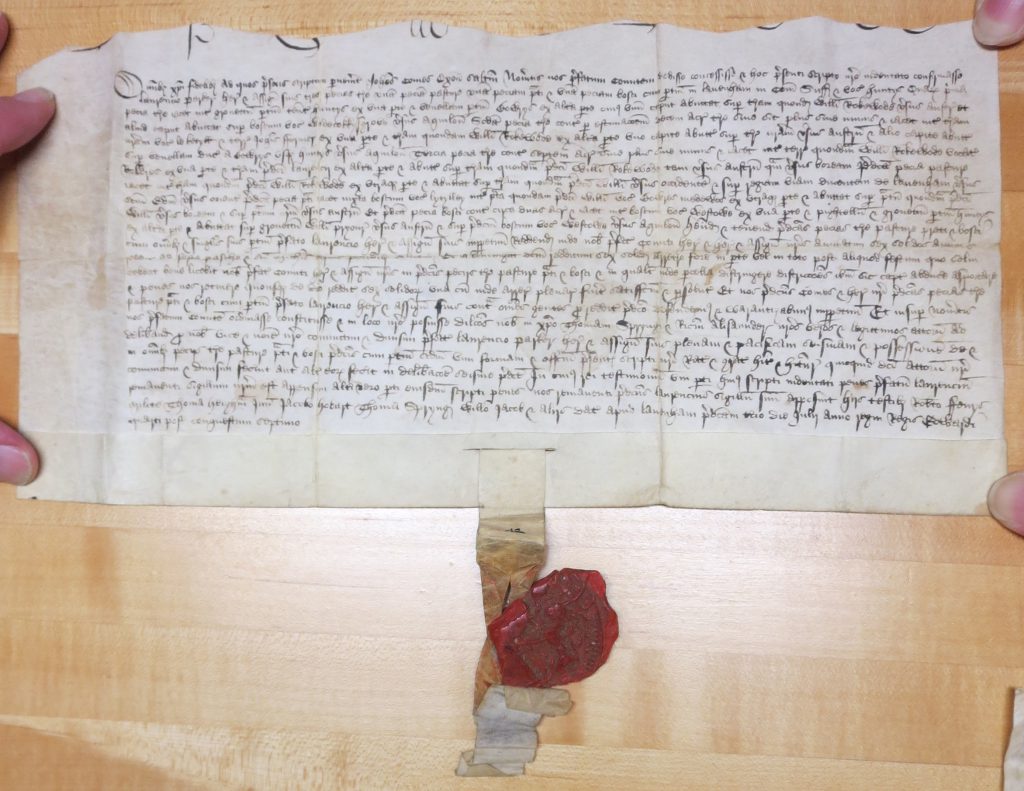
Preston Charter 12 Face with Seal. Photograph Mildred Budny.
*****
Workshop 8
“Face the Music, or,
Where Manuscript Meets Print
in a Hybrid Book:
An Early-Modern German Herbal
with a Reused Binding Fragment
from a Medieval Musical Manuscript”
Sunday 26 October 2025
[Note the Change in Date from 7 September]
This workshop will examine a puzzling vellum fragment (or is it a set of patchwork fragments?) in a private collection. The fragment(s) come(s) from a single musical manuscript in Latin on vellum laid out in double columns with text and notation on 4-line staves. The reused medieval material forms the outer covering of a 17th-century printed book in German on laid paper.
We will work to decipher the visible parts of the text and music, identify the readings/lections and chants, and, if possible (given the fragmentary nature), determine the probable genre of original manuscript, such as lectionary, breviary, or missal. Perhaps we might find other survivors from the same despoiled medieval manuscript.
Plus we will exclaim over the features of the printed book, which includes illustrations and marginalia in forms of annotations demonstrating attention of several kinds.
What brought this medieval musical fragment and early modern printed book together? Even if we might never know all the answers, won’t it be fun to question how and why? There is a story here.
We love the puzzle, and give thanks to the collector for lending the book to the RGME for study and teaching.
Information
Registration for the Workshop
The Manuscript Fragment and the Printed Book

Private Collection, Front Cover with Reused Medieval Musical Fragment on Vellum. Photograph by Mildred Budny.
Title Page
[Bartholomaeus Carrichter (1510–1574)], Horn des Heyls menschlicher Blödigkeit, oder Kreütterbuch, darinn die Kreütter des Teutschenlands auss dem Liecht der Natur nach rechter Art der himmelischen Einfliessungen beschriben / durch Philomusum Anonymum [Bartholomäus Carrichter], with a foreword by Michael Toxites, born Johann Michael Schütz (1514–1581), (Strassbourg: Anton Bertram, DCVI/1606).

Private Collection, Kreutterbuch, title page. Photograph by Mildred Budny.
For the first edition of 1576, printed in Straßburg, see an online digital facsimile of a copy in Augsburg, Staats- und Stadtbibliothek. For an edition of 1619 also printed by A. Bertram, see the copy in the Wellcome Collection.
Like the 1619 edition, this folio volume has 10 unnumbered pages, 180 numbered pages, and 5 unnumbered leaves, with a woodcut title page and outline illustrations.
*****
Workshop 9
“Books as Thresholds and Communities”
Sunday 21 December 2025
We propose hold the next Workshop on 21 December.
As the year 2025 draws to a close, we reflect on our Theme for the Year, “Thresholds and Communities” particularly as it applies to our explorations of books and their makers, users, collectors, readers, and others — through our series of workshops and other events — and as we prepare for next year and its new theme.

Poster 2. 2025 Autumn Colloquium. Poster set in RGME Bembino.
Because the 2025 RGME Autumn Colloquium in late November will consider the subject of Fragments (manuscript and printed) from many perspectives, we may discuss some discoveries from that event and follow up with more materials which it helped to bring to light.
For example, do you have any manuscript or printed fragments that you would like to share or learn about? Bring them along, please, to our Zoom Meeting. Let’s see what we might learn together, and share the delight of discovery.
Registration
See you there!

Illumination from Hildegard’s Scivias (1151) showing her receiving a vision and dictating to teacher Volmar. Image Public Domain via Wikimedia Commons.
******
Workshop 10, Etc.
Subjects To Be Determined (We accept requests!)
Among subjects requested are:
Cataloging Manuscripts: Readers’ Perspectives
Or, A User’s Guide to the Catalogue You Always Wanted
Manuscripts and (or Versus) Photography
A User’s Guide
‘Hybrid Books’: What Are They?
Examples and Case-Studies
Manuscripts as Thresholds
For our 2025 Theme of “Thresholds and Communities”,
we consider how manuscripts might function as Thresholds and represent or foster Communities
Note our sessions and roundtable at the 2025 IMC at Leeds on the subject of
“Manuscripts as Worlds of Learning”
*****
Questions? Suggestions?
Visit our Social Media:
Join the Friends of the RGME.
Please make a Donation in Funds or in Kind for our nonprofit educational corporation powered principally by volunteers. Your donations and contributions are welcome, and can go a long way. They may be tax-deductible to the fullest extent provided by the law.
*****

Private Collection, Pieces of a Vellum Leaf from a Medieval Manuscript: Verso. Photography by Mildred Budny.





















